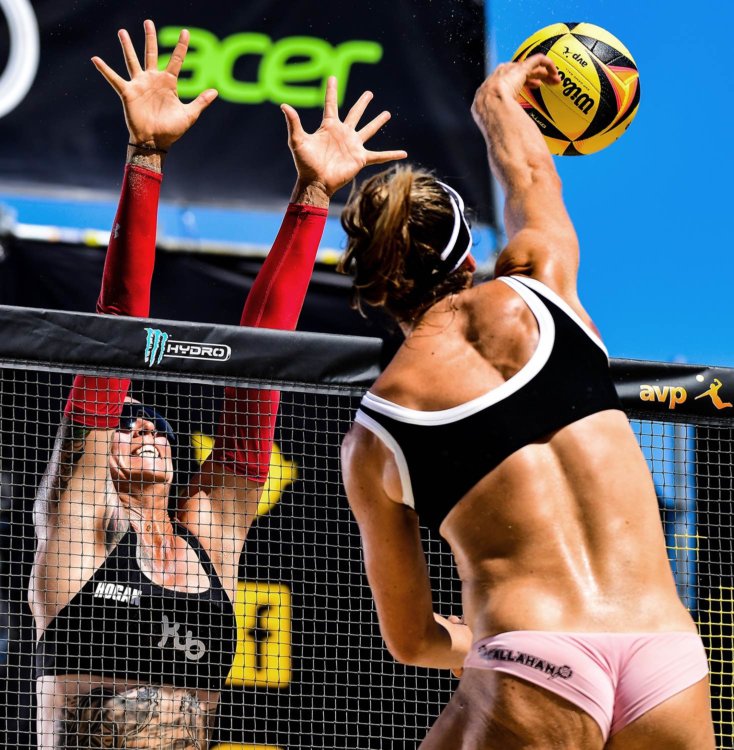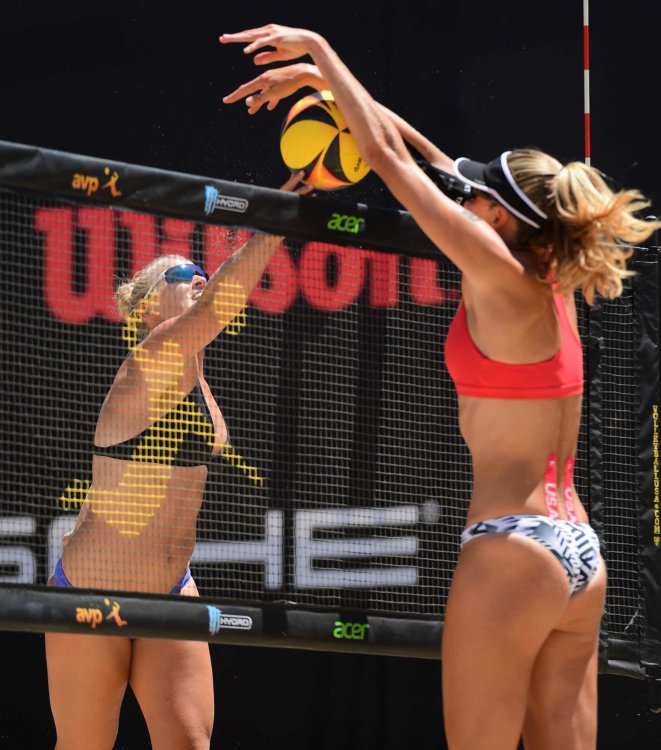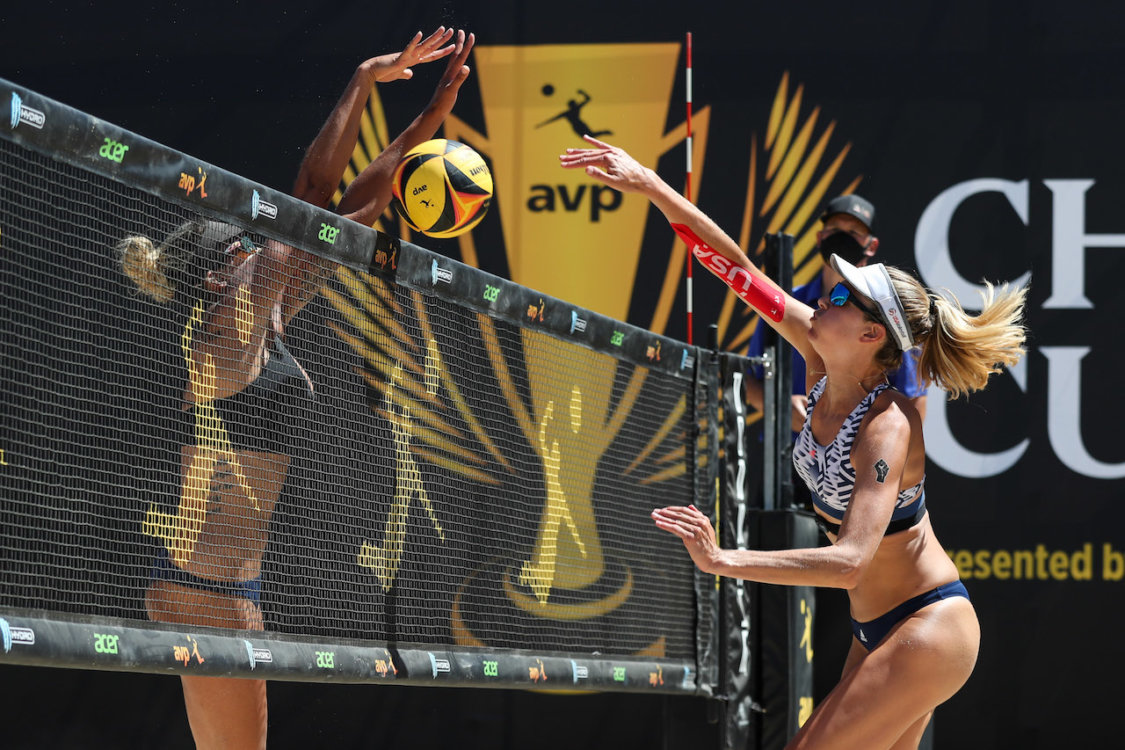We’re finally to my favorite skill – blocking!
I was good at blocking even when I sucked at volleyball. Being 6’3″ at 13 years old with reasonably decent intuition and hand-eye coordination helps. But blocking also requires the least amount of skill compared to all the other technique-intensive volleyball movements.
Or so you’d think.
The thing about blocking is: you’d think it would be as simple as jumping high and putting your hands up. But there’s so much more nuance to it, especially on the beach. And since this is an AVP article, I’m focusing solely on beach blocking. Even though the skill that transitions best from indoor to beach is blocking (in my opinion), they’re still different in a bunch of various ways. But I digress.
Blocking in beach is a one-on-one battle. And I am here for it. But blocking isn’t just about getting the stuff and impending “Moooooonster Block!” moment. It’s not even about touching the ball. It’s about running your defensive strategy and cutting off your opponent’s angles. This is where the blocking calls come into play. But first, let’s talk about body position and hands.

Say you’re the blocker and already at the net waiting for your partner to serve. It’s best to line up in the middle, so you’re only a few steps away from either player. Your partner serves. Once you see the ball cross your eyeline, you should move to the side of the court in which the ball is traveling. Once your opponent passes, you should be tracking and watching for a few different things:
- Is this a good pass that they’re going to get a great set off of? If not, you may begin considering pulling (we’ll go over that another time).
- Is the opponent who didn’t pass going to attack this ball instead of setting it? If so, you need to watch where they’re looking, what their body is doing, and adjust accordingly.
- Are they calling for any set variance – i.e., “to the pin” or “back”? If so, you need to haul over there and position yourself where the set will end up.
Let’s assume it’s a good pass. This is the AVP, after all. You want to line up where the pass is/where the setter is taking the ball UNLESS you hear a different set being called OR see the hitter setting up somewhere other than a normal hit. Most setters will set up and down right in front of them, and this is obviously where the hitter will also attack the ball. So it’s best to be here. The variant sets require moving to where they’re calling. With these, you have to be ready to adjust and sometimes even make your final movement based on the hitter’s body language. Back and pin sets are generally harder to predict.
Still with me? Good. So the setter is setting up and down, you’re waiting in a loaded-and-ready position. Knees bent, body tense and anticipatory. Your hands should be in front of you, body about one arm’s length from the net, arms bent and inside your body. Arms out to the side do nothing for you – they’ll be slower to bring to blocking position and less controlled once you’re up there. Your hand should be taught and in a “W” shape. Meaning thumbs up and parallel to each other, fingers spread wide.

Once the hitter comes to the ball, there’s an eye sequence you must do before you jump into action. It goes:
Ball – Setter – Ball – Hitter
Really, this eye sequence begins as the ball is passed. But the progression happens naturally until the second half; it’s easy to track the ball after the pass and then watch the setter as they contact. The “Ball – Hitter” part is harder to master. Most people want to look at the ball basically the whole time, especially when it’s being hit (myself included). That makes sense; if you’re trying to block something, you need to know where it is.
With this sequence, you’re still allowed to track the ball before you look at the hitter. But then you have to trust you know where it will end up. You’re not going to learn any new information from a volleyball falling out of the sky. But you will learn a lot from watching where your attacking opponent is looking, where their body is facing, how intensely (or not) they’re taking their approach, where their shoulder is facing, and what their hand looks like as they contact the ball.
See? That’s a lot of data to mine from the hitter. But this takes a loooooong time to master. Our instincts are like puppies: “ball, ball, ball, look, there’s a ball. I want the ball!” Blockers excel when they actively work against that and instead focus on gathering data.
It’s imperative when you and your partner are doing “read defense.” This means you’re both watching the play develop and adjusting your defense to your opponents’ cues. You don’t have specific zones you’re taking (line or angle). If you see someone come in really hard to the angle, the blocker should take that away from them while my partner would focus on digging the line shot or poke over the block. Reading also forces you to pay ample attention to the hints from the other side of the net. Sometimes when I block certain angles, I get bogged down in covering my zone instead of intuitively clocking the game and adjusting accordingly.
Now for the block itself. Timing is key; you want your hands to push over the net right as or right after your opponent hits. If you jump early and your hands are just chillin’ over the net, they’ll be able to attack around your block.

The block motion is a push over the net. Hands need to be taught and as big as they can be. Your thumbs are still up and parallel; you’re pushing across the net and into the court (so your block lands in the court). If the ball is tight, you want to wrap it up, barely not touching it. Remember – you want to take as many options away from the hitter as possible. If the ball is off the net a bit, you focus on taking as much area as possible. I still consider a field goal (when a hit goes through your arms) a good block attempt.

Emily Day wrote an informative piece on block calls – I highly recommend perusing that for details on what we’re doing with our hands behind our backs. Because these calls are absolutely crucial. Only two people are responsible for an 8×8 meter court. You have to be on the same page to cover as much ground as possible.
This refers to what I mentioned earlier. Blocking isn’t all about stuffing or even touching the ball. Most attackers won’t challenge a good block – they’re going to hit around you. So you, as the good blocker, need to give them fewer options around your hit. When they attack full-force at your partner, a good block will “funnel” it there. Funneling means taking up enough space that the hitter has to hit sharply away from the block. A good funnel means there’s little court the blocker isn’t taking away from the hitter. And the court that’s still available is where the defender waits.
So that’s the long and short of it. Again – seems like the most straightforward skill. But against seasoned and smart players, blocking becomes exponentially more challenging. You see Nick Lucena taking a last-second look as he hits? That’s because he’s watching the defense set up. He knows what defensive scheme they’ve called and therefore, where their weakness lies in that play. It’s all pretty incredible. And why, as always, I recommend you get out there and get some experience. That is hands-down the only way to get better. And there’s little better in life than improving in beach volleyball.
